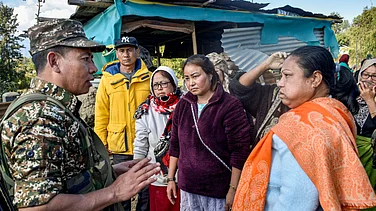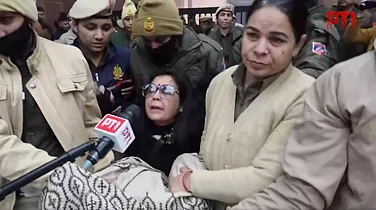Nisha, a 25-year-old woman living in Yamuna Khadar, East Delhi, is washing her kids’ clothes by the riverside. Housed a few meters away from the Yamuna river, she often uses its water to carry out her domestic chores. "The water is less dirty than before, thanks to the monsoon," she says. Nisha has always lived in Yamuna Khadar, and earns 200 rupees a day, as a laundry worker. Her daily life is marked by mosquito bites and diarrhoea. And she is one among several people whose lives are ruled by diseases due to toxic emancipation from the river water.
"Yamuna is a damned river. Living near the river can cause many diseases due to toxic emanations of methane for instance," explains Depinder Kapur, director of the water program at the Center for Science and Environment. "Only 50 per cent of the Delhi water is being treated. The rest, a mix of chemical waste and wastewater, is thrown in the Yamuna. There is an assumption that pollution is caused by people living in slums around the river. This is not true. Pollution is happening because of untreated sewage and industrial causes," she adds.
Bhavita, 30, owns a little shop in Yamuna Khadar. She has been living in the slum for the past 15 years. "I suffer from a constant cold and bad cough because of air pollution," she says between two coughing fits. The slum is located under a bridge, where thousands of cars are driven every day.
Concerning water supply, people from Yamuna Khadar get free drinking water every week, brought by trucks from the Delhi municipality. "We also receive some occasional help from NGOs," adds Zawid Ali, 67, a slum resident. "We experience some itching and skin diseases. Some government doctors come and visit from time to time," he adds.
But according to the slum occupants, this is not enough and they demand free and good quality medical care. Speaking with Outlook, they said that they often self-diagnose and buy their medication in pharmacies, to save time and money.
Polluted water and toxic gas
About twenty kilometres from there, in North Delhi, stands a brown and shapeless mass --- a 60-meter-high mountain of waste: Bhalswa. According to Rajender Kumar Ved, an entrepreneur in scrap materials working in Bhalswa, 10,000 families live around the landfill site. Waste workers are busy on the mountain of waste, looking for glass, metal, and plastic. With their backs bent, and their noses in the garbage, they work without protection and are exposed to malaria, tetanus, skin diseases, and attacks from scabies dogs.
"Waste pickers also get sick because of the groundwater they use for domestic purposes," says Shashi Bhusan, founder of All India Kabari Mazdoor Mahasangh. "During the summer, we are exposed to mosquitoes. I have already been ill, the atmosphere made me sick. I went to a private clinic and paid 2,000 rupees to receive healthcare. I had no choice. Medical care in public hospitals is not good and takes too long," says Mazid, a 40 years old waste-picker. While Mazid is explaining his working conditions, toxic smoke emanates from the landfill. Last April, a massive fire broke out at Bhalswa, caused by methane generation.
According to a Chintan report, waste pickers’ life expectancy is around 39 years and the most common diseases the urban poor experience are fever, cough, skin disease, asthma and tuberculosis. This also concerns children living in landfill. Even though most of them receive an education thanks to NGOs and public schools, they are often left to their own devices after school, and at best play in the dump, at worst help their parents segregate the waste.
Open defecation
Open defecation is also a major health issue. In Yamuna Khadar, there are no toilets available, and people have to walk several hundred meters to relieve themselves. "It is unsafe for women to defecate in the open," says Reena, a 35 years old woman living in Yamuna Khadar. "Children repeatedly fall ill because of the filth around and mosquitoes," she says.
In October 2019, the Narendra Modi government declared the country open-defecation-free. But despite this statement, many states and cities in India still face some open-air defecation, due to a lack of toilets.
According to some 2015 numbers, Bhalswa has five toilet complexes, and the slum does not have piped drinking water, like Yamuna Khadar. It is the local municipal tankers that supply drinking water to the residents. According to the 2021 National Family Health Survey, while 83 per cent of households have access to a toilet facility in India, 19 per cent practice open defecation. Lack of sanitation and hygiene causes various diseases, such as diarrhoea, typhoid, cholera, hepatitis, polio, trachoma and others.





















